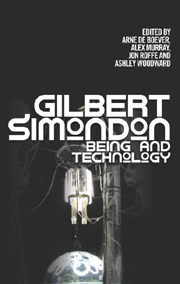Book contents
- Frontmatter
- Contents
- Abbreviations
- Editors' Introduction: Simondon, Finally
- 1 Technical Mentality
- Explications
- 2 ‘Technical Mentality’ Revisited: Brian Massumi on Gilbert Simondon
- 3 Identity and Individuation: Some Feminist Reflections
- 4 Crystals and Membranes: Individuation and Temporality
- Implications
- Resonances
- Glossary: Fifty Key Terms in the Works of Gilbert Simondon
- Notes on Contributors
- Index
2 - ‘Technical Mentality’ Revisited: Brian Massumi on Gilbert Simondon
from Explications
Published online by Cambridge University Press: 12 September 2012
- Frontmatter
- Contents
- Abbreviations
- Editors' Introduction: Simondon, Finally
- 1 Technical Mentality
- Explications
- 2 ‘Technical Mentality’ Revisited: Brian Massumi on Gilbert Simondon
- 3 Identity and Individuation: Some Feminist Reflections
- 4 Crystals and Membranes: Individuation and Temporality
- Implications
- Resonances
- Glossary: Fifty Key Terms in the Works of Gilbert Simondon
- Notes on Contributors
- Index
Summary
Question (Q): Several years ago, you tried to get Simondon translated – and to no avail. We thought we could start with the question: why Simondon today? One can see why it would be important, historically, that Simondon is finally translated into English. But is there any reason why his thought strikes you as particularly relevant – philosophically, politically, culturally – today?
Answer (A): I did make strenuous efforts over a number of years, starting almost twenty years ago, to have Simondon translated for a book series I was co-editing. The director of the press flatly refused to consider it, saying there was no interest in Simondon and no audience for the work. At the time, he was probably right. Now the translations are under way, and are impatiently awaited in many quarters, with a sense that they are long overdue. So what changed? Why today?
It might help to start by talking about, why not then? The early 1990s was a very particular moment in English-speaking academics and cultural thought. The intellectual movements of the preceding three decades had succeeded in chipping significant cracks into the walls separating the academic disciplines, which had undergone a process of increasing specialization in the postwar period that many experienced as a Balkanization of knowledge. It wasn't just a question of the much-discussed ‘two cultures’ divide between science on the one hand and the humanities and social sciences on the other.
- Type
- Chapter
- Information
- Gilbert SimondonBeing and Technology, pp. 19 - 36Publisher: Edinburgh University PressPrint publication year: 2012



